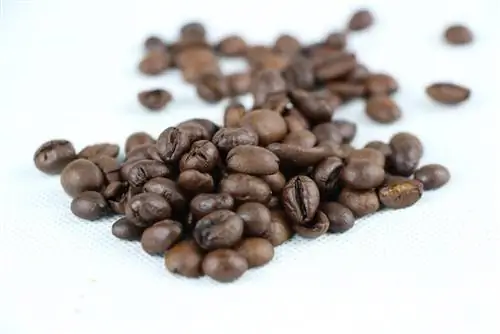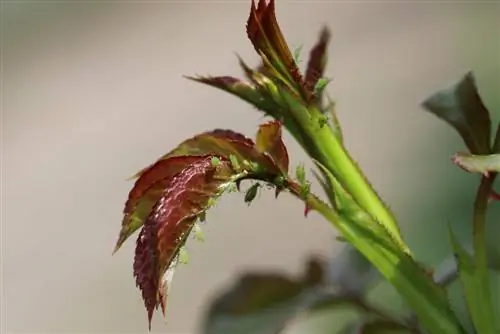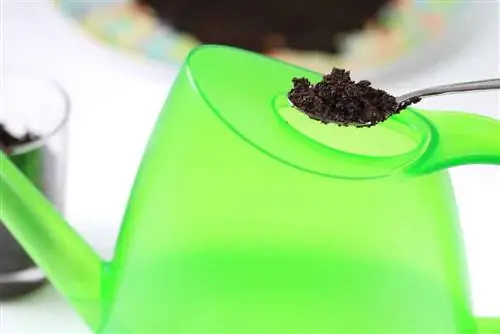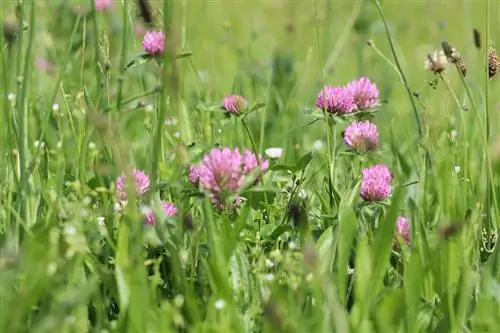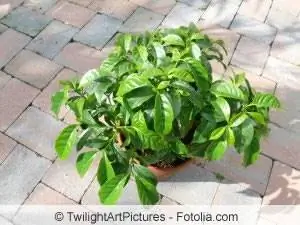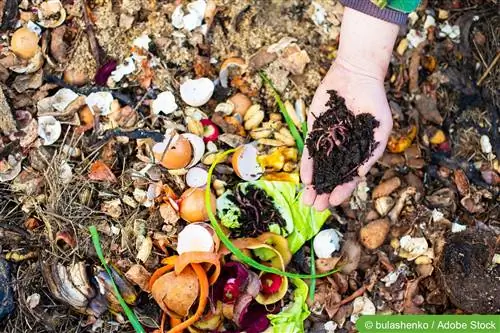- Author admin [email protected].
- Public 2023-12-17 03:39.
- Last modified 2025-06-01 06:48.
If you are looking for a particularly environmentally friendly and cost-effective method to fertilize your plants, you are well advised to use coffee grounds. Because this supposed waste product is free of harmful substances and can be reused in many ways. Hobby gardeners particularly like to use coffee grounds as a natural fertilizer. Read here which plants the home remedy is best suited for!
Coffee grounds in the garden at home
Coffee grounds contain numerous minerals, with the potassium, nitrogen and phosphorus content being particularly worth mentioning. Plants need these substances in order to grow and thrive. In addition, earthworms are magically attracted to the coffee grounds, which in turn loosen the soil with their movements. But not only that, they also leave behind droppings, which also provide important nutrients for the plants. On top of that, coffee grounds keep a number of pests and bugs away and lower the pH value of the soil. Therefore, this home remedy is particularly beneficial for plants that prefer acidic humus soil.
Berry bushes
For many hobby gardeners, berry bushes are considered essential in the design of their garden. And rightly so, because the bushes are not only a visual eye-catcher, but also produce tasty fruits that are great for snacking on. The he althy, low-calorie berries grow best when grown in a location that is as sunny as possible. Most berry bushes prefer loose, humus-rich and deep soil. The bushes are usually fertilized in spring and autumn, with compost being used in particular. You can also fertilize these berry bushes with coffee grounds without any concerns:
Blueberries
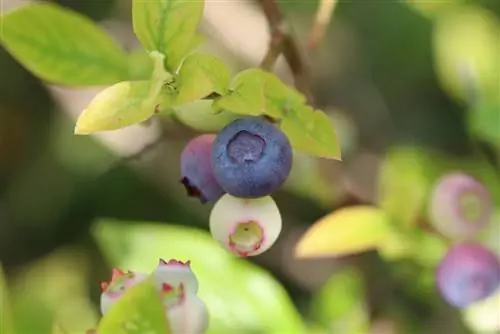
The blueberries prefer a location in full sun that is also protected from wind and weather. They thrive best in natural soil, such as acidic sandy soil. The soil should, if possible, be permeable and free of lime. Regular watering is essential so that the shrub produces its black-blue, round berries from July to September. Although the blueberries cannot tolerate waterlogging, they do require plenty of moisture. To do this, it is worth providing the plants with a layer of mulch into which the coffee grounds are incorporated.
- Latin name: Vaccinium myrtillus
- Synonyms: blueberry, blackberry, wild berry, wild berry
- Genus: Blueberries (Vaccinium)
- Growth height: up to 2 meters
- Growth habit: dwarf shrub
- Special features: lives up to 30 years
Blackberries
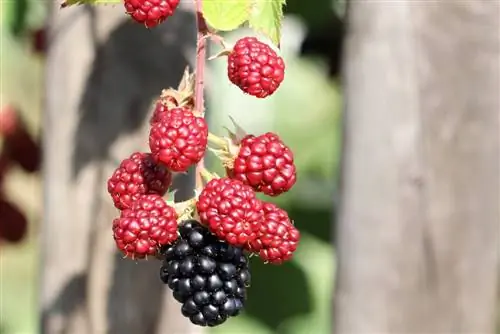
The blackberries are best planted in moist soil, which is also humic, well ventilated and slightly acidic. The shrub is not particularly demanding when it comes to choosing a location, as it thrives in both a sunny and a partially shaded spot. The plant is fertilized from the beginning of April, although it is advisable to create a layer of mulch to suppress any weeds. If the plant is cared for professionally, it usually produces blue-black fruits, which visually resemble berries, but are actually collected drupes. In addition, the blackberry is often used as a medicinal plant for diarrhea, gum inflammation or colds.
- Latin name: Rubus sectio Rubus
- Synonyms: wild berry
- Genus: Rosaceae
- Growth height: up to 3 meters
- Growth habit: climbing shrub
- Special features: used as a medicinal plant
currants
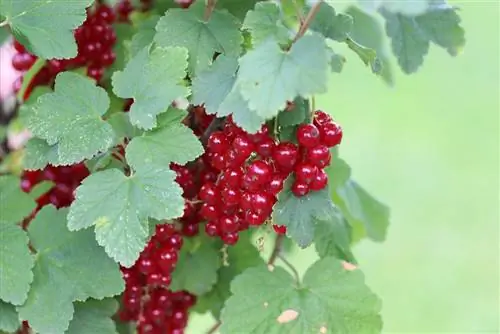
The undemanding currants can be grown in a sunny or partially shaded place. However, the sunnier the plant is, the better the sweetness of the fruit develops. This berry bush prefers moist soil, but it cannot tolerate waterlogging. It is also important to ensure that it is rich in humus and nutrients. It is best to add plenty of compost to the soil in spring and then mulch it. The coffee grounds can be incorporated into the compost as well as into the mulch layer.
- Latin name: Ribes
- Synonyms: currant, sea cloudy
- Genus: Gooseberry family (Grossulariaceae)
- Growth height: 1 to 1.5 meters
- Growth habit: shrub
- Special features: mostly deciduous, rarely evergreen
Vegetable plants
More and more hobby gardeners are using their garden to provide for themselves and grow tasty vegetables. Nature-conscious people in particular swear by self-sufficiency, and rightly so! Only by growing your own can you be certain that the plants will not come into contact with pesticides or other pollutants. The nutrient supply can be ensured with numerous organic fertilizers, although some vegetables can also easily be fertilized with coffee grounds.
Pumpkin
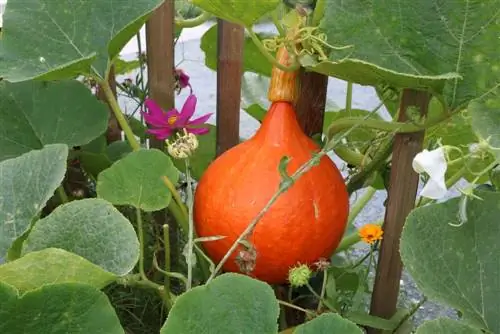
If you want to grow tasty pumpkins in your garden, you should have enough space for this. The pumpkin plants also need at least six hours of sunlight per day, which is why they are preferably grown in a sunny to full sun location. The plants are watered regularly so that the soil is constantly moist. A nitrogen-rich complete fertilizer is mixed into the irrigation water every week to provide the plants with sufficient nutrients. Alternatively, compost into which the coffee grounds are incorporated is also suitable.
- Latin name: Cucurbita
- Synonyms: melon fruit
- Genus: Cucurbitaceae
- Growth height: several meters
- Growth habit: low-lying and herbaceous
- Special features: requires a lot of space
Cucumbers
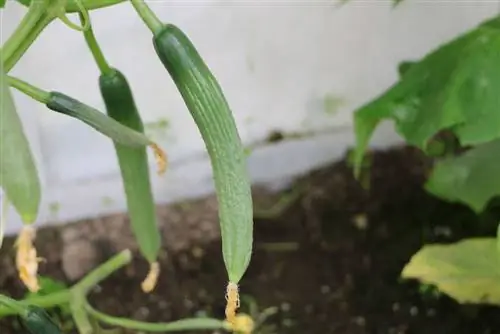
The cucumbers prefer a location in full sun that is also protected from the wind. When choosing the soil, make sure that it is humus and loose. This vegetable plant is a heavy feeder, which is why it always needs to be supplied with enough nutrients. Since it also requires a lot of water, it is advisable to create a layer of mulch. This means that the soil stays moist for longer, which in turn benefits the fruits. The cucumbers can easily be fertilized with coffee grounds, especially since these can also be incorporated into the mulch layer.
- Latin name: Cucumis sativus
- Synonyms: Kukumber
- Genus: Cucurbitaceae
- Growth height: up to 3 meters
- Growth habit: climbing or on the ground
- Special features: the fruits are actually berries
Tomatoes

Tomatoes are among the vegetable plants that benefit most from fertilization with coffee grounds. Because they are also heavy eaters and need to be constantly supplied with nutrients. They also need a lot of water on an ongoing basis, which is why mulching the tomato plants is also advisable. To ensure a productive harvest, the nightshade plant should be grown in a warm and sunny location.
- Latin name: Solanum lycopersicum
- Synonyms: love apples, paradise apple, tomato sauce
- Genus: Nightshade family (Solanaceae)
- Growth height: 30-400 cm
- Growth habit: depends on variety
- Special features: botanically speaking, the fruits are berries
Zucchini
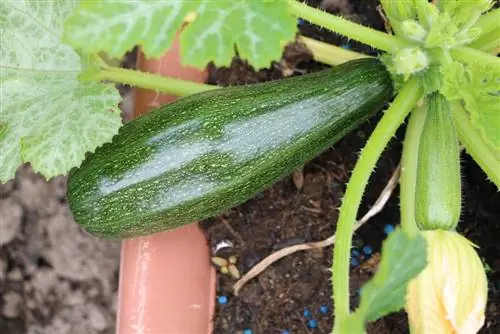
The Mediterranean vegetable can be easily grown in the home garden as long as it is provided with a sunny and warm place. The zucchini also need enough space, which should also be protected. The soil should be loose and well-drained, humus-rich and nutrient-rich. To protect the plants from weeds, it is worth creating a layer of mulch. This also has the advantage that the soil stays moist longer.
- Latin name: Cucurbita pepo
- Synonyms: zucchini
- Genus: Cucurbitaceae
- Growth height: 1 to 1.5 meters
- Growth habit: herbaceous, creeping
- Special features: Flowers are edible
Ornamental plants
For most hobby gardeners, it is hard to imagine growing ornamental plants in the home garden without it. The selection of decorative plants is enormous and offers the hobby gardener the opportunity to design the garden according to his own wishes. Many of these ornamental plants can also be supplied with nutrients inexpensively by fertilizing them with coffee grounds. The following plants in particular benefit from the home remedy:
Angel Trumpet
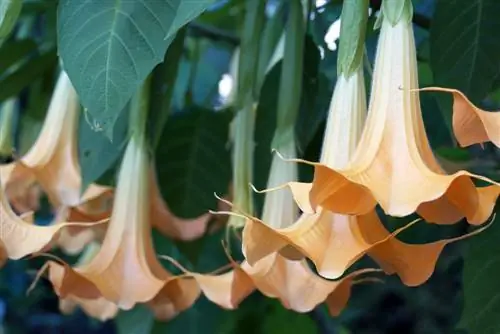
The angel's trumpet impresses with its yellow flowers, which can be both fragrant and unpleasant smelling. They prefer a place protected from the wind and should not be exposed to direct midday sun. Due to their large leaves, they require a correspondingly high water requirement, which is why they should be watered daily, especially in summer. The angel's trumpet is also considered a heavy feeder and is often attacked by snails. That's why the decorative plant benefits even more from the coffee grounds. On the one hand, it provides it with sufficient nutrients and on the other hand, the home remedy keeps the snails away.
- Latin name: Brugmansia
- Synonyms: Evil Eagle Tree, Burundanga
- Genus: Nightshade family (Solanaceae)
- Growth height: 2 to meters
- Growth habit: shrubs or trees
- Special features: all parts of the plant are highly poisonous
Geraniums

The geraniums, whose correct name is pelargoniums, come from South Africa and therefore prefer a location in full sun to partial shade. They also need a lot of water, which is why the soil should always be evenly moist. A permeable and nutrient-rich soil is also ideal for this heavy feeder. It is best to incorporate a long-term fertilizer into the soil directly when planting. The geraniums are fertilized weekly or fortnightly by mixing a liquid fertilizer into the irrigation water. If this ornamental plant is cared for professionally, it will decorate the garden with its magnificent flowers. These can be colored pink, white, red or purple and have patterns such as stripes or spots.
- Latin name: Pelargonium
- Synonyms: cranesbill
- Genus: Cranesbill family
- Growth height: up to 50 centimeters
- Growth habit: bushy
- Special features: blooms permanently
hydrangeas

The natural population of the hydrangea is mainly found in the temperate to warm regions of East Asia. In home gardens it prefers a semi-shady to shady location protected from the wind. The optimal soil is humus-rich and has a pH value between 5 and 6. The hydrangea also has a high nutrient requirement and should therefore be adequately supplied with nutrients. When watering, make sure that this ornamental plant prefers rainwater and cannot tolerate waterlogging. If cared for professionally, the hydrangea produces numerous flowers from July to August, which can be white, blue, red, green or purple.
- Latin name: Hydrangea
- Genus: Hydrangea family (Hydrangeaceae)
- Growth height: up to 2 meters
- Growth form: subshrub or shrub
- Special features: pink farmer's hydrangeas can change flower color to blue
Rhododendrons
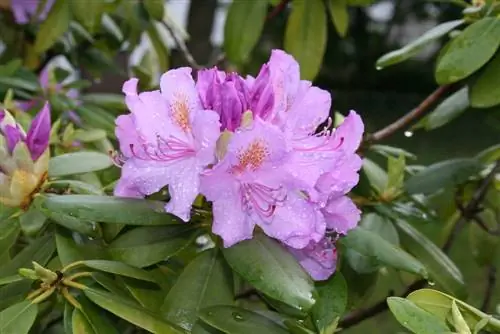
The rhododendrons are particularly decorative ornamental plants and appear like gigantic rose bushes. There are around 1,000 different types of rhododendrons known worldwide, some of which can grow to be several meters high. However, low-growing species are usually preferred for cultivation in home gardens. The rhododendrons are best planted in loose, humus-rich and acidic soil. When choosing a location, you should also make sure that the plant is not exposed to direct sun. Rhododendrons also need a lot of moisture, which is why they should be watered regularly, especially in dry periods.
- Latin name: Rhododendron
- Synonyms: alpine rose, rose tree
- Genus: Heather family (Ericaceae)
- Growth height: up to several meters
- Growth habit: mostly small flowering bushes
- Special features: some species are trees
Storage & Shelf Life
It is best to dry the coffee grounds and mix them into the soil. The dry coffee grounds can be stored almost indefinitely if stored dry, cool and dark.
Conclusion
Coffee grounds are an inexpensive and environmentally friendly fertilizer that is suitable for fertilizing numerous plants. Whether berry bushes, useful or ornamental plants - many plants in home gardens benefit from the ingredients in coffee grounds. The home remedy also attracts useful earthworms and at the same time keeps pests and vermin away.

